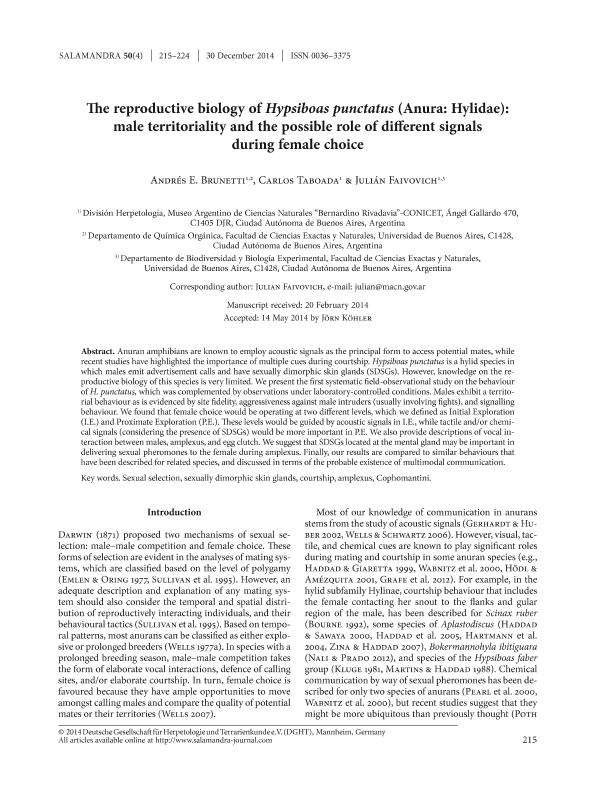Mostrar el registro sencillo del ítem
dc.contributor.author
Brunetti, Andrés Eduardo

dc.contributor.author
Taboada, Carlos Alberto

dc.contributor.author
Faivovich, Julián

dc.date.available
2017-06-29T18:32:13Z
dc.date.issued
2014-12
dc.identifier.citation
Brunetti, Andrés Eduardo; Taboada, Carlos Alberto; Faivovich, Julián; The reproductive biology of Hypsiboas punctatus (Anura: Hylidae): male territoriality and the possible role of different signals during female choice; German Society for Herpetology and Herpetoculture; Salamandra; 50; 4; 12-2014; 215-223
dc.identifier.issn
0036-3375
dc.identifier.uri
http://hdl.handle.net/11336/19143
dc.description.abstract
Anuran amphibians are known to employ acoustic signals as the principal form to access potential mates, while recent studies have highlighted the importance of multiple cues during courtship. Hypsiboas punctatus is a hylid species in which males emit advertisement calls and have sexually dimorphic skin glands (SDSGs). However, knowledge on the reproductive biology of this species is very limited. We present the first systematic field-observational study on the behaviour of H. punctatus, which was complemented by observations under laboratory-controlled conditions. Males exhibit a territorial behaviour as is evidenced by site fidelity, aggressiveness against male intruders (usually involving fights), and signalling behaviour. We found that female choice would be operating at two different levels, which we defined as Initial Exploration (I.E.) and Proximate Exploration (P.E.). These levels would be guided by acoustic signals in I.E., while tactile and/or chemical signals (considering the presence of SDSGs) would be more important in P.E. We also provide descriptions of vocal interaction between males, amplexus, and egg clutch. We suggest that SDSGs located at the mental gland may be important in delivering sexual pheromones to the female during amplexus. Finally, our results are compared to similar behaviours that have been described for related species, and discussed in terms of the probable existence of multimodal communication.
dc.format
application/pdf
dc.language.iso
eng
dc.publisher
German Society for Herpetology and Herpetoculture
dc.rights
info:eu-repo/semantics/openAccess
dc.rights.uri
https://creativecommons.org/licenses/by-nc-sa/2.5/ar/
dc.subject
Hylidae
dc.subject
Hypsiboas
dc.subject.classification
Zoología, Ornitología, Entomología, Etología

dc.subject.classification
Ciencias Biológicas

dc.subject.classification
CIENCIAS NATURALES Y EXACTAS

dc.title
The reproductive biology of Hypsiboas punctatus (Anura: Hylidae): male territoriality and the possible role of different signals during female choice
dc.type
info:eu-repo/semantics/article
dc.type
info:ar-repo/semantics/artículo
dc.type
info:eu-repo/semantics/publishedVersion
dc.date.updated
2017-06-28T19:41:01Z
dc.journal.volume
50
dc.journal.number
4
dc.journal.pagination
215-223
dc.journal.pais
Alemania

dc.description.fil
Fil: Brunetti, Andrés Eduardo. Consejo Nacional de Investigaciones Científicas y Técnicas. Oficina de Coordinación Administrativa Parque Centenario. Museo Argentino de Ciencias Naturales "Bernardino Rivadavia"; Argentina
dc.description.fil
Fil: Taboada, Carlos Alberto. Consejo Nacional de Investigaciones Científicas y Técnicas. Oficina de Coordinación Administrativa Parque Centenario. Museo Argentino de Ciencias Naturales "Bernardino Rivadavia"; Argentina
dc.description.fil
Fil: Faivovich, Julián. Consejo Nacional de Investigaciones Científicas y Técnicas. Oficina de Coordinación Administrativa Parque Centenario. Museo Argentino de Ciencias Naturales "Bernardino Rivadavia"; Argentina
dc.journal.title
Salamandra
dc.relation.alternativeid
info:eu-repo/semantics/altIdentifier/url/http://www.salamandra-journal.com/index.php/home/contents/2014-vol-50/379-brunetti-a-e-c-taboada-j-faivovich/file
Archivos asociados
